|

By Daniela Rizzo
Having a pond is
a dream for a lot of people- a corner of the world where enjoying plants,
fishes, frogs, birds, and the amazing show of nature is an everyday occurance.
For aquarium hobbyists, a pond is a natural progression, an outdoor extension of
indoor aquaria. I’m a Central American cichlid lover, and in my tanks, I don’t
keep a lot of plants. I limit myself to the toughest ones, such as Anubias
and Vallisneria, but in my pond, I love to maintain all the plants that I
can grow in it! Talking with other pondkeepers, I’ve noticed the problem is
always the same: the lack of time. We all have to balance work, the family,
sports, hobbies, walks with dogs, aquarium maintenance, etcr... Where can we
find the time to dedicate to the pond and the energies to work in it,
transplanting, fertilizing, and caring for the naughty rare tropical
Nymphaea, which doesn’t produce any leaves?
The answer is
simple and obvious: Since the least exciting task is caring for pond plants,
let’s choose species that are undemanding, easy to cultivate and readily bloom
and reproduce. So if you don't have a lot of time, you should avoid exotic and
delicate Nymphaea, or plants that need to be winter- grounded. And
to save time and have success in cultivating any plant, here are some
useful tips:
Buy the plants
only in the right season: if you’ve read (reading BEFORE buying is a wise
habit) that Sagittaria need to be planted in September, don’t do it in
December!
When you arrive
at home with the new specimen, usually sold in plastic pots, don’t settle them
immediately. Take two or three days to check if the chosen position is
really the best.
What are some hardy, easy-to-care-for
species? Here are just a few:
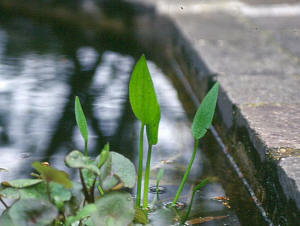 |
Alisma
plantago-aquatica
(Alismataceae) is diffused in the European temperate zones. This bog
plant offers a weak resistance to the intense cold. During the
winter the aereal part disappears but in the early spring new leaves
sprout again. You can plant
Alisma in a mix of coarse sand and soil at a depth between 5
and 25 cm,. Place the plant in a mid-sunny position, but possibly
far from fountains, as strong surface movement can damage the
leaves. To reproduce, you can subdivide the plants, paying attention
to the roots. |
|
|
All
Hedychium (Zingiberaceae) species originate from India and
south-eastern Asia. They have beautiful, sweet-smelling flowers like
orchids, but don’t tolerate temperatures below 7°C. Not real swampy
plants, they can be settled on the banks in a rich soil. In the
autumn, it is important to cut off floriferous stalks. These plants
reproduce by stolons, but you can also divide the rhizome. |
|
Hibiscus
(Malvaceae). Many species belong to this genus, but some are too big
for a pond, like H. syriacus. H. moscheutus (syn.
H. palustris) is obviously the most suitable for a pond.
Indigenous to south of the USA loves sunny places where grow up to
2.5 meters. The flowers are pink with a darker inner part. They
remain open only during the day, but there are many flowers. The
plant is in full bloom during the summer. H. coccineus comes
from southern United States, and needs protection during the winter,
otherwise the leaves will die. This plant has amazing buds that
become beautiful big red flowers from July to September. If you want
to reproduce Hibiscus, you can sow in the spring, but if you
divide the plants in autumn, you’ll have a wonderful blossom next
June. Cultivate them in a mix of soil and sand. |
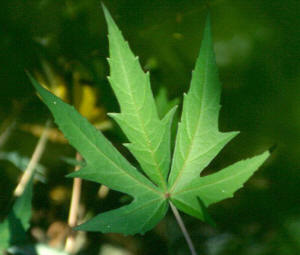
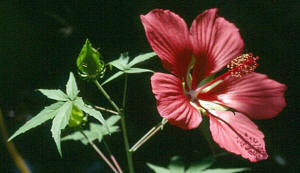 |
Hosta
lancifolia (Liliaceae)
is a perennial plant coming from China and Japan. This species is sought after
for it's decorative green leaves. The plant loves shady places, but needs sun
for several hours a day to bloom. You can plant Hosta in fertile soil in
March or October. From June till September, you’ll enjoy the graceful
lilac flowers. Hosta rarely produces seeds, so to reproduce, it’s better
to divide the plant.
Houttuyinia
cordata (Saururaceae)
comes from China and Japan and has very beautiful green leaves, red or
white-edged. Strange for bog plants, Houttuyinia spreads a delicate scent
that attrracts butterflies. In March or September, you can plant this species
eight centimeters deep, laying the rhizome horizontally. During the summer, the
flowers will bloom, but if the season is warm, we can have two flowering periods
each year. This plant will reproduce without problems; you have only to wait.
H. cordata can live in a shadowy corner of your pond, but to maintain the
red leaf edge, it needs intense light, so let the sun shine directly on your
plants.
Iris
(Iridaceae). There are hundreds of species and varieties of Iris.
Iris laevigata, Iris pseudoacorus and Iris kaempferi
are suitable for ponds, where they live in 15 - 45 cm deep water. Iris
kaempferi comes from China and Japan, is a strong plant, and during the
winter, can live in dry soil. The flowers, which are white, violet, and pink,
appear in June. The plant produces many stolons but if you want to reproduce
Iris by seeds, you have to wait April. Remember: this plant doesn’t love
hard, alkaline water or sunny places. Iris can grow up to 80 cm, and are
perfect for a second border, planted in tuft.
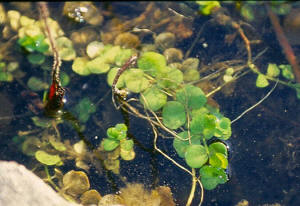
Lysimachia
nummularia
(Primulaceae) This genus is distributed throughout Europe, America
and Asia, where they colonize bogs and inundated shores. L. nummularia
can live in any position, but needs sun to produce yellow flowers. The leaves
are rounded and lie on the water surface in “branches” long up to 40
centimeters. Don’t submerge
Lysimachia, it lives well in very shallow water, at a depth of
5-10 cm. From May to September the plants bloom, in September you can divide the
pot contents into new plants, using soil mixed with sand.
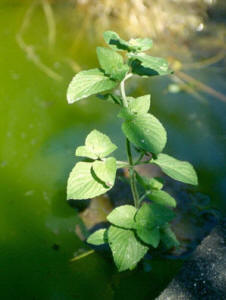
Mentha
aquatica (Labiatae) is
a perfect plant for every pond! You can cultivate this lovely plant for years
without problems. During harsh winters, the leaves die but will spring up again
durig the first warm days.This plant prefers shady positions,and if the sun is
strong, the leaves become pale green. The little white or lilac flowers bloom
from May to the end of the hot season, Mentha is quite hardy,
and soon you’ll have new nice plants (without doing anything!) invading your
pond.
Mimulus
ringens
(Scrophulariaceae) is found in North America, and is rather strong. This
beautiful plant with small violet flowers thrives in shady positions and in
shallow water up to 10 cm deep. It can reach 50 cm in height, and is a good
plant for covering the banks and the edge of the pond. In September, don’t
forget to plant Mimulus. The next year, you’ll have many tufts of this
plant to divide. Last year, I transplanted young Mimulus blooming plants
during a hot July (no fun) and they continued producing flowers and new leaves
without any trouble!
Pontederia
cordata
(Pontederiaceae) is found in the temperate zones of North America. This tall
plant (up to 1 meter) is reccomended for a rather big pond, where it
prefers sunny places in warm, stagnant or low-current waters. You have to plant
them at a depth of 20 cm maximum in a rich soil. From June to September, the
flowers bloom. In April or May, you can cut the rhizome (always use a sharp
knife to avoid mold and rot) and plant its portions in 6-7 cm deep water. If all
goes right, the plant will produce many stolons. Pay attention if you keep
turtles with this plant. Mine have eaten a 60 cm high Pontederia in only
one day!
Sagittaria
sagittifolia
(Alismataceae) comes from Europe, but many other species of this genus live in
America and Asia. This plant has big, ornamental, sagittated leaves (hence the
name).When the water is deep, the submerged leaves are different, ribbon-like.
In June, you can plant only young specimen while adult ones could be disturbed
by sun and wind. During the summer the plant blooms, masculine flowers don’t
ripen at the same time with feminine ones, to avoid self-pollination. The
stolons of all species of Sagittaria carry small light-blue or green
tubers (regarded as edible in Asia) in which the plant stores reserves of
nourishing matter for the cold winter. To reproduce this species, you can
subdivide the rhizome in March or cut off from the mother new small plants.
And now for the
floating plants, to be successful with their cultivation we need warm air and
water, low flow, and rich soil in the pond to release nourishing substances to
the floating roots. Remember: goldfishes and turtles love small floating plants
as meal.
| Eichornia
crassipes
(Pontederiaceae) originates from Central America, but by now has
infested warm water in all of the temperate world. In the wild
Eichornia creates floating islands that give harbour to
thousand of fishes ( perfect plant for Cichlid lovers). This plant
can live also in very shallow water with the roots in the ground. It
rarely produces seeds, but new plants grow during the summer when
temperature reaches 25°C. If you haven’t success with Eichornia
the main problem is the poorness of the water. |
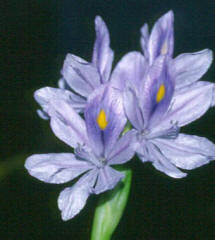
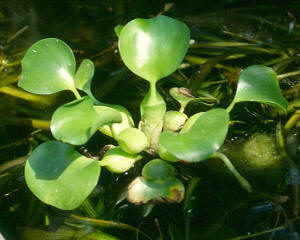 |
Pistia
stratiotes (Araceae) is
diffused through the temperate zones in all the world where the temperature
flows between 20° and 30°C. Loves sunny and shady places but needs high water
quality. If the velvety, nice leaves turn yellow, iron is needed. In the summer,
Pistia will produce new plants.
Salvinia
auriculata
(Salviniaceae) native to Tropical America and absolutely wants sun, warm air and
fertil soil. If the light is enough, the leaves crowd together, lifting their
edges from the water similar in appearnace to an ear, hence the name
auriculata. Salvinia reproduces by spores.
And now you have
only to try and enjoy your pond!
|
|
